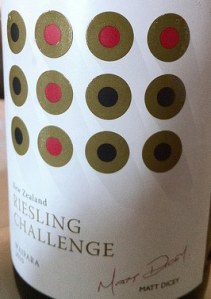Tastes Like Home: Experimenting with Waipara Riesling
Post by Chuck Hayward | September 28th, 2011
Terroir is a hot topic, no doubt. The idea that winemakers are required to transmit the specific qualities of a plot of land to a finished wine is gaining traction, and for many critics, it is considered bad form for the vigneron to leave an imprint that reflects personal style. That camp believes the winemaker's role is to act as minimally as possible and take a hands-off approach in order to highlight a wine's terroir.
However, I think it’s impossible to separate the impact of man from winemaking. We as humans are the ones who recognize superior vs. inferior terroir. Growers decide what grapes to plant and how to grow them. Winemakers make endless judgments about when to pick grapes, what yeast to use, how long to age, and so on. The actual decision to practice minimalist winemaking is probably the most important choice that can be made.

- Wine writer Dan Berger inspects a bottle of his favorite varietal
Cut to an interesting tasting recently sponsored by New Zealand Winegrowers, responsible for educating consumers and the trade about kiwi wines. In 2010, twelve New Zealand winemakers agreed to create wine from the same batch of fruit— riesling from the Waipara growing region just outside of Christchurch—and were given four tons of uncrushed fruit from Mud House vineyards. They each produced 250 cases of wine at their own facilities, scattered throughout six of the country's growing regions.
The Participants and Their Wineries:
Ant McKenzie, Te Awa (Hawkes Bay)
Duncan Forsyth, Mount Edward (Central Otago)
John Forrest, Forrest Estate (Marlborough)
Jules Taylor, Jules Taylor Wines (Marlborough)
Larry McKenna, Escarpment (Martinborough)
Matt Dicey, Mt. Difficulty (Central Otago)
Matt Donaldson, Pegasus Bay (Waipara)
Mike Brown, Golden Hills Estate (Nelson)
Patrick Materman, Brancott Estate (Marlborough)
Paul Bourgeois, Spy Valley (Marlborough)
Simon McGeorge, Waiprara Hills (Waipara)
Simon Waghorn, Astrolabe Wines (Marlborough)
I hoped this project would answer a few questions: How well is the Waipara terroir transmitted in each of their wines? Can the winemaker's imprint be easily recognized?
The Answers
I searched and searched for the Waipara character I have come to understand over the years, the Mosel-like aromatics and the mineral-laced flavors. But though each winemaker came with a long history of producing riesling, they also came from areas as diverse as the cold reaches of Central Otago to the warmer climes of Hawkes Bay.
Tasting through the flight, it was clear the wines reflected a wide array of styles, ranging from taut, mineral driven examples to richly textured, sweet bottlings. The finished wines showed alcohol levels ranging from 9.0-12.8% and residual sweetness varied between bone-dry to medium-plus sweet. When the wines were presented to New Zealand wine critics, Matt Donaldson' version was selected as top wine. In San Francisco, Matt Dicey and Ant McKenzie tied for top honors.

- Matt Dicey's Riesling
At the end of the day, my top three wines included the bottlings from Matt Dicey, Matt Donaldson and Simon Waghorn. What struck me was how closely each of their wines resembled the style from the region where they worked. In other words, the riesling from Matt Dicey (who makes wine at Mt. Difficulty in Central Otago) tasted like an Otago riesling. Simon Waghorn has worked in Marlborough for years and his wine was a classic rendition of what Marlborough riesling should be. Meanwhile, Matt Donaldson, who was accustomed to riper fruit, manipulated the grapes by freezing them to concentrate their sugar level and his final product tasted exactly like it came from Pegasus Bay!

- Matt Donaldson's Winning Riesling
In looking back at the tasting, it was less about how the terroir of Waipara was expressed in these bottlings. Instead, I walked away realizing that each winemaker had fashioned a wine more reflective of the terroir they called home, almost as if they took their previous creations and experiences and imposed them on the fruit used for this project.
Which poses the question… can you take terroir with you?